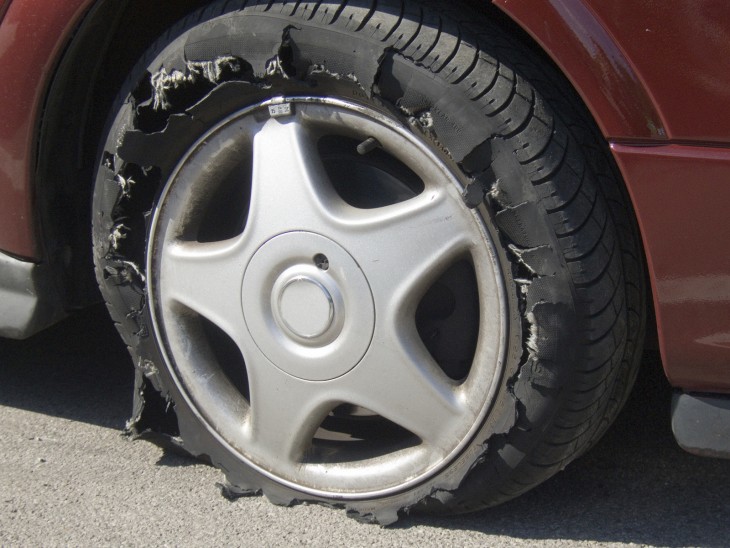When a tire blows out, the experience can be dangerous and scary. However, if you remain calm and implement the proper procedures, you can avoid serious injuries or damage.
What Causes a Blown Out Tire
Tire blowouts cause thousands of accidents each year. However, most blowouts can be prevented.
If you run over a sharp piece of glass or a nail, the object could lodge into your tire, which will cause a slow air leak. Though, if you drive over a sharp object at a high speed, your tire will likely blow out. This is why you should always dodge debris on the road. However, if you cannot avoid debris on a highway, slow down before you drive over it.
Potholes should also be avoided because if you hit them at a high speed, you could pop your tire. Curbs should be avoided too because the sides of a tire are the most sensitive areas. If your tire rubs up against a curb, it might burst; in addition, the curb will scratch your rims.
Proper air pressure increases the lifespan of your tires, improves gas mileage, provides a smoother ride, and prevents blowouts. The sides of your tires will overly flex if the pressure is too low. As a result, the tires will overheat and split.
What To Do When a Tire Blows Out
After the tire bursts, do not stomp on the brakes. If a tire blows out at the rear, reduce your speed gradually and steer it to the edge of the road. Your car might vibrate a lot, but the vibration will not make you lose control of the vehicle.
If a steering tire blows out, you will probably feel a strong pull on the left or right side of your vehicle. You should not panic during this situation; instead, hold the steering wheel firmly and use force to straighten out the vehicle.
How To Repair a Blown Out Tire
First, turn off your engine and engage the emergency brake. Then loosen the lug nuts on the damaged tire by using your tire iron. Lift the corner of your car with your jack. You should put the jack under the specific jack point. If your vehicle does not have a jack point, place the jack under a sturdy point, such as under the frame or axle. Do not use the jack in any other location because it will damage your vehicle. Next, remove the loosened lug nuts and take the tires off your car. Put the spare tire on the wheel hub and secure it with the lug nuts. Then, tighten the nuts with your hand using a clockwise motion. Lower your vehicle slightly so that the new tire contacts the ground; however, the tire should not bear the vehicle’s full weight. Finally, completely tighten the lug nuts with your tire iron. Then, carefully lower your vehicle to the ground.
Benefits of Recycling Your Tires
In the past, the process of disposing tires was difficult. Today, many recycling facilities use tire shredders that reduce tires to tiny pieces quite quickly.
You should recycle your tires because it prevents contamination at landfills. Contamination occurs because the acidity and moisture in soil reacts to vulcanized tire rubber. As a result, the chemicals that were created during the vulcanization process are absorbed into the water in the ground. If the tires have heavy metals, they will leach out from the material as well. Contamination kills bacteria in the ground; when this happens, the ecosystem will not function properly. However, you can stop this from happening by shredding your tires at a recycling facility.
